Blog home / Walking the West Highland Way: "This is why people come to Scotland"
Having to brave the cold and wet weather on many occasions, Tom learnt that happiness in Scotland is walking with wet, cold feet. And there were plenty of moments and jaw-dropping scenery that left Tom thinking: “This is why people come to Scotland."
Starting from the north of Glasgow and into the highlands of Scotland, Tom shares his day-to-day experiences, local encounters and the history that unfolds on this iconic trail.
Day 1: Milngavie to Drymen
My main complaint about the Camino de Santiago was how difficult it was to find accommodation. So before I started walking the West Highland Way, I contacted a travel agency, Walkers' Britain, and had them arrange everything which included a luggage transfer.
Because this is the first day, the luggage handler wanted to meet me and tell me to leave my luggage every morning exactly where I had found it the night before. I promised to follow his instructions; he then complimented me on my fine Midwestern American accent. That was nice to hear.
The people of Scotland have their own way of speaking the English language. I can't decide if it's a lovely lilt or if it sounds like they are being strangled as they speak. Either way, it is definitely distinctive.
The West Highland Way has brought an economic revival to some of the more remote areas of Western Scotland.
The arch in Milngavie, a village in the suburbs of Glasgow and pronounced Mool-guy, marks the beginning of the path. To reach the trailhead I took a local train from the main station in Glasgow to Milngavie where I spent the night in a hotel.
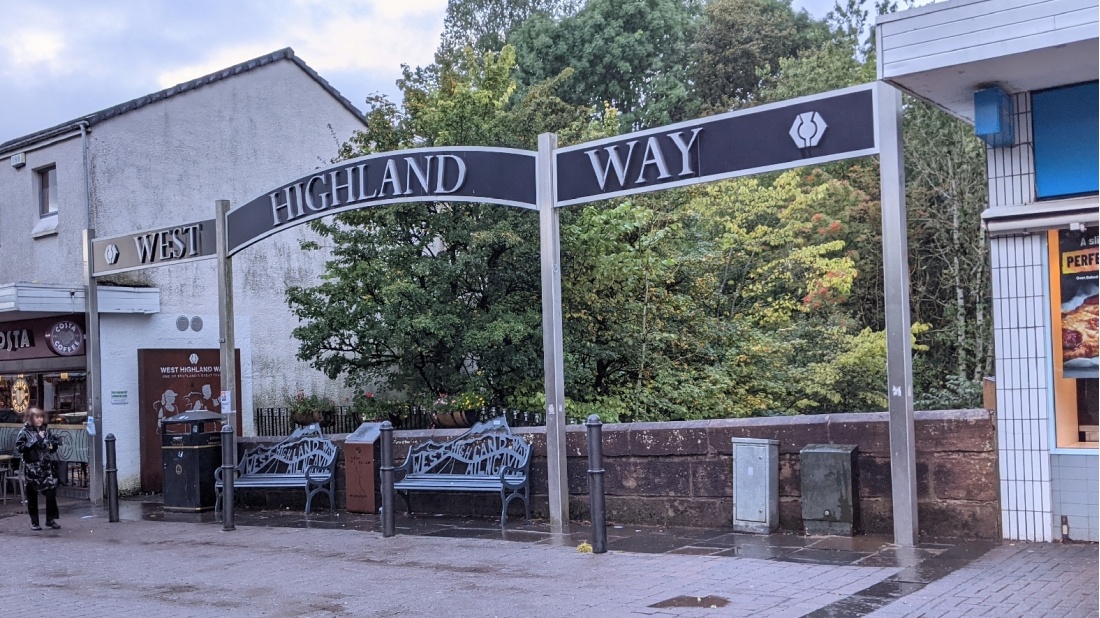
Waking up this morning, the rain was coming down in sheets, but by 8:00, the rain had eased and the trail looked fine. The trail made for easy walking all day, the challenge was that it would rain, stop raining, the sun would shine, and then it would rain again. As soon as I had taken off my rain jacket, I felt I was putting it back on. But at times I would come out of the forest and the views would be spectacular. As the day continued, I learned that neither my waterproof boots nor my waterproof jacket is actually waterproof.
Fortunately, I have some wool socks that I hope to wear tomorrow and a long sleeve Merino wool t-shirt so even though I will probably be wet, I'm hoping that I will be reasonably warm and that hypothermia won't set in. There were very few other people on the path and I only met one other walker, Ian.
Tonight finds me in the village of Drymen (rhymes with liven'). Drymen's claim to fame is having the oldest pub in Scotland. I looked inside – it seemed small and uncomfortable. But what do I know? It's been in business since 1734 so they must be doing something right.
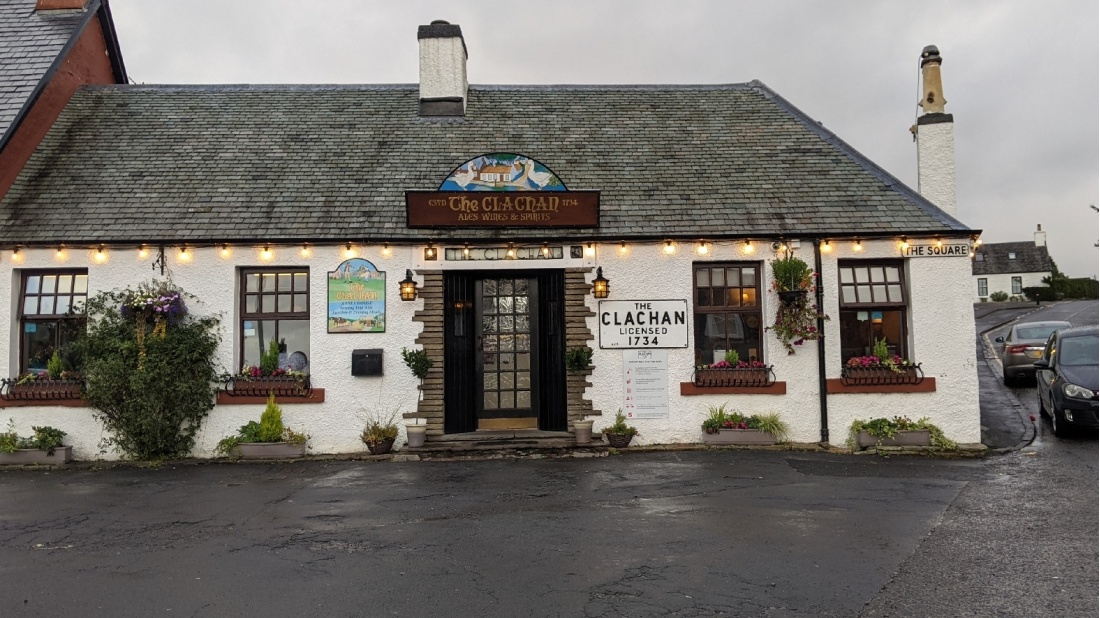
Today was, according to the guidebook, the easiest day of the walk. But after 12 miles of walking, I was totally exhausted. Tomorrow it will rain and, the locals tell me, I will have a much more difficult walk.
Day 2: Drymen to Rowardennan
The woman who runs the Kip and the Kirk guest house, where I stayed last night, charms all her visitors. As soon as I arrived, I was given a scone and a cup of tea.
This morning I was served a hearty breakfast of tea, toast, peanut butter, cereal, and fruit as she patiently answered all my tourist questions. The woman, Frances, ran the New York City Marathon, teaches yoga, and rounds things out by teaching driver education in Drymen.
Leaving the Kip in the Kirk guest house, the sun was shining and everything looked good. Thirty minutes or so out of town the path took a turn up a hill and shortly thereafter I got my first good look at Loch Lomond. It is the largest inland body of water in Britain, about 37 km or 23 mi long. At its deepest point, it's 190 m or 623 ft deep.
The West Highland Way follows the shore for 30 km or 19 mi. From here, I can see some islands, which are now uninhabited. Centuries ago people lived on them because they felt safe – sort of like they do now in gated communities.
After another hour or so I reached the settlement of Balmaha (which rhymes with Omaha) where there is a small cafe. To my surprise, I met some hikers in the cafe who were walking in the other direction and were wild camping. The rest of the day was really difficult. On the map, it looks like the path follows the shore. In fact, the path goes up, down, and around the steep ravines that line the lake.
I found that some of the rock stairs were much more challenging than others. Taking a short rest to drink some water, I was joined by a little Robin who seemed to think I was a pretty interesting guy. However, the rain never let up. When I arrived at my stop for the night, a youth hostel, it was 4:00 p.m. and I'd been walking for 7 hours.
Once again I was totally exhausted. Plus my feet were wet, cold, and shriveled. Apparently, tomorrow will be the roughest day of the walk and the forecast is for rain all day. As I drank my coffee, I saw that the sky had cleared. Walking back outside, the day was ending in a flurry of colour.
Day 3: Rowardennan to Inverarnan
This was the coldest morning yet, 43'F or 6℃. But walking quickly warmed me up enough to be comfortable in just my wool base layer and rain jacket. The path started off very nicely and soon I was in a forest, walking beside a steep hillside and passing more waterfalls than I could count. The path followed the shoreline with a very steep drop-off. Other times, the path led up through narrow, rugged stone passageways. It then took a swerve around a private dock with a coffee shop attached.
Just as I went to open the door of the shop, out stepped Ian, the wild camper who was going to live on just peanut butter. Things weren't going well for him.
His first night of wild camping had been reasonable, but by the second night all his clothes were wet and he couldn't find a way to dry them, his sleeping bag couldn't keep him warm, and he thought he might get hypothermia. To save himself from putting up his tent he had opted for one of the two free public huts on the West Highland Way. One of the seven people in the one-room stone huts (called bothies) was a woman who slept with her dog in her sleeping bag – the dog kept whimpering all night. Besides that, the weight of his backpack was killing him - he had pain everywhere in his body. "I am," he said in summary, "shattered, completely shattered."
I walked with Ian for a bit before we parted ways to change my socks. As I sat there fumbling with my socks a German woman walked up, said hello, and waited for me to put my socks and boots on as if we were old friends. Lydia and I walked together for the rest of the day. She said that she actually was enjoying the walk because it made her feel like a mountain goat.
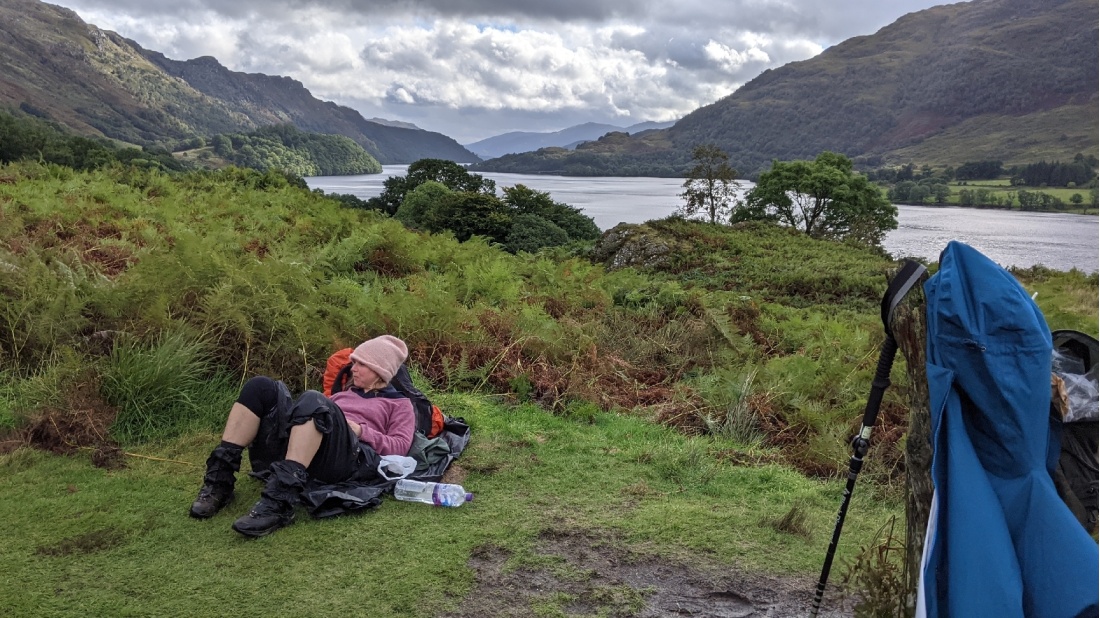
As we walked, she would occasionally pause to pick mushrooms and berries for her dinner. She was going to stay in a campground and cook her harvest of mushrooms and berries from the path on her camp stove. Gradually the path turned up and away from the lake where we had our last good look at Loch Lomond.
Reaching my hotel, The Drover's Inn, I felt like I had a pretty successful day.
The Inn is one of the oldest hotels in Scotland. It has been open since 1704 and is somewhat of a museum with a suit of armour, stuffed birds, various weapons, a standing stuffed bear, and hundreds of knick-knacks. It also features very small rooms and bathrooms down the hall.
As I checked in, Ian showed up and told me that he had decided to take a bus home tomorrow. He just can't take it anymore. We had dinner together and later Lydia came over and joined us for a beer. Ian had totally given up on his peanut butter diet so instead, he had a giant meal of a traditional Scottish meat and potato dish. He said it was delicious.
Day 4: Inverarnan to Tyndrum
Breakfast in The Drovers Inn was pleasant. All of the other guests were walkers and we congratulated each other on having survived such a rough day.
If it's rough for us, what about the drovers? The drovers were the men who took the cattle from the highlands of Scotland to England. They must have been as hard as nails and as tough as any American plains Indians or Mongolian herders.
Wearing only kilts and wool blankets, they led cattle through the hills by day and, after finding a place for the cattle to rest at night, frequently slept outside. When they reached England, the locals there thought they looked pretty scary - unbathed, unshaven, and undoubtedly smelling worse than the animals they guided. I can imagine that only Scotch whiskey made their lives somewhat bearable.
To the staff of The Drover's Inn, it was, of course, just another day at work. They all, by the way, wear traditional Scottish kilts and yet almost all of them were Romanians who came here for seasonal work.
As I started walking, it was raining and it would continue to rain all morning. In the afternoon, it eased up a bit before starting again. Never mind, the path was much easier. Most of the path would even have been very pleasant if it had not been so wet.
After a couple of hours, my boots and body were, as usual, completely soaked. For the first hour or so the path followed a raging river and for stretches, the path seemed to be flowing water or just mud. Later, however, the path passed through thick pine forests, and carefully managed estates.
In this area, there's a big movement towards developing a sustainable form of agriculture and forestry. This area is, as you might expect, dotted with various historical monuments--mostly ancient battle sites where nothing is left except the memory. Today the path passed by the ruins of an ancient monastery.
Accommodation for the night was a family-run bed and breakfast, the Glengarry House. They open for guests at 3pm.
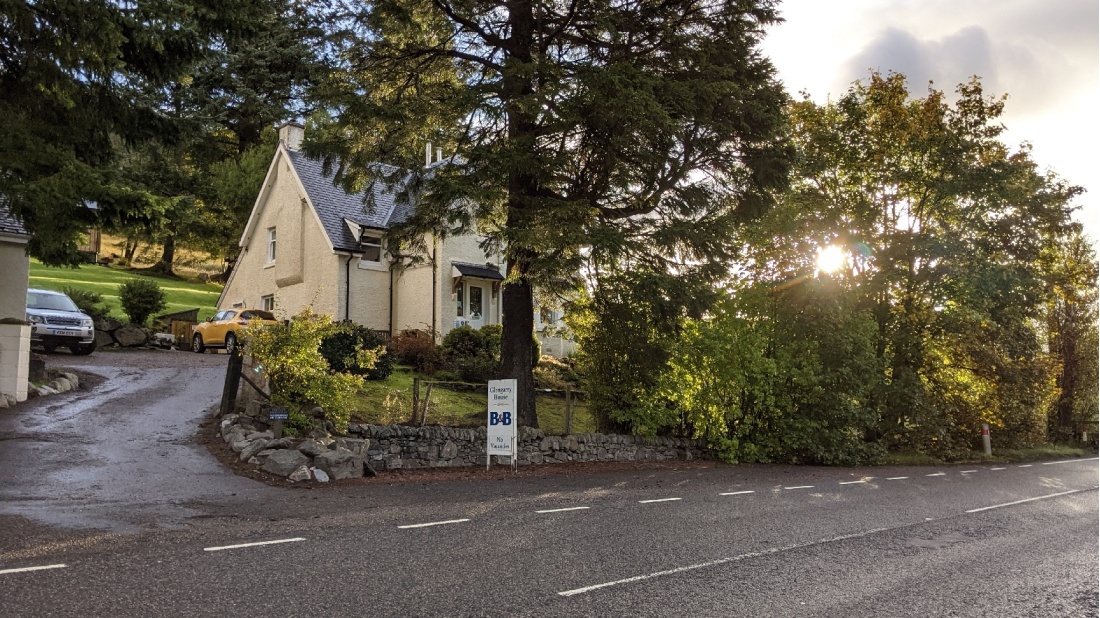
Day 5: Tyndrum to Bridge of Orchy
Yesterday someone told me that happiness in Scotland is enjoying walking with wet, cold feet. As of this morning, I can add, "putting on boots that stink."
As I was leaving my guesthouse the manager told me that for the next two days, there will be no shops or towns. He recommended that I stop in the local grocery store, Brodies Mini Market, to buy whatever supplies I needed.
Today's path was an old military road. About 1750, the British decided that if they were going to squash the local rebellions they needed a road system that would allow them to rapidly move troops around Scotland. It was much more manageable than the path around Loch Lomond.
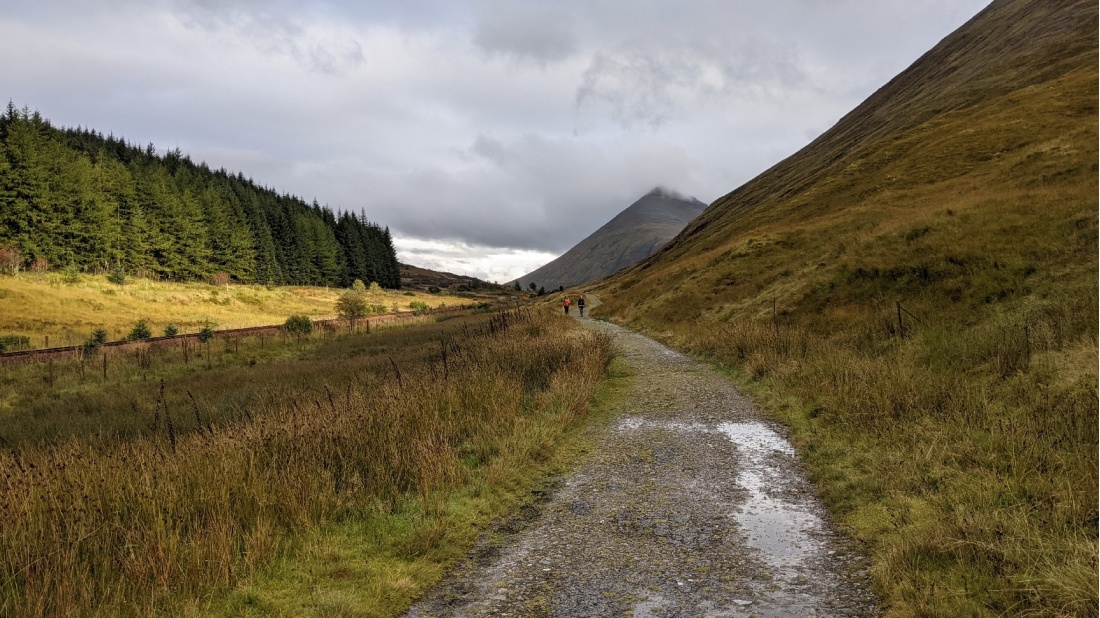
I only met one man, his wife, and their dog for the entire day. Besides their dog, I met some other animals on the path, none of whom were shy at all about having their picture taken.
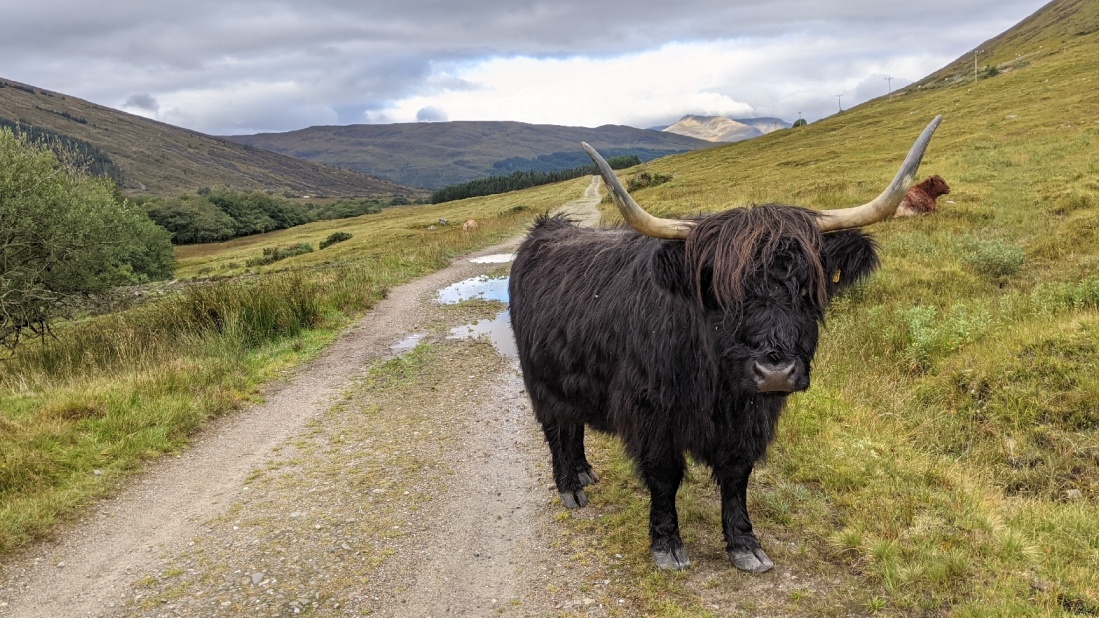
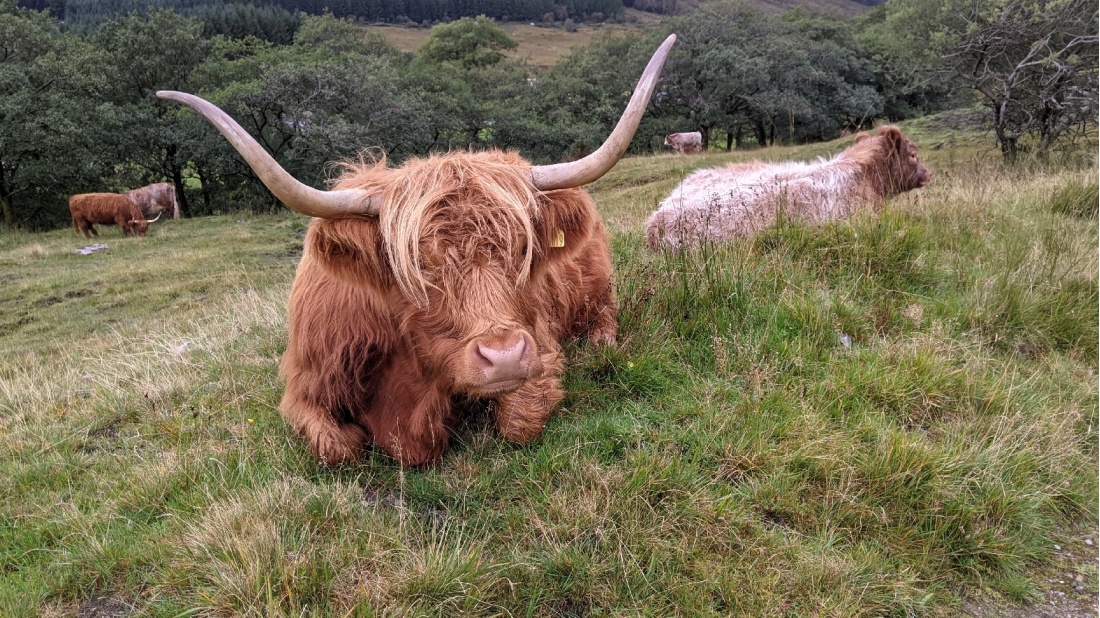
I arrived at my hotel for the night, the Bridge of Orchy, an hour before check-in but the nice lady at the desk let me check in anyway. I have no complaints about the room.
Day 6: Bridge of Orchy to Kingshouse
Every hotel has either given me a packed lunch or breakfast. Today it was breakfast.
From across the bridge, the path led up through hills to a summit that I arrived at just as the sun was coming over the larger ridges – giving me an incredibly wonderful view of Rannoch Moor below. "This is, "I thought, "why people come to Scotland."
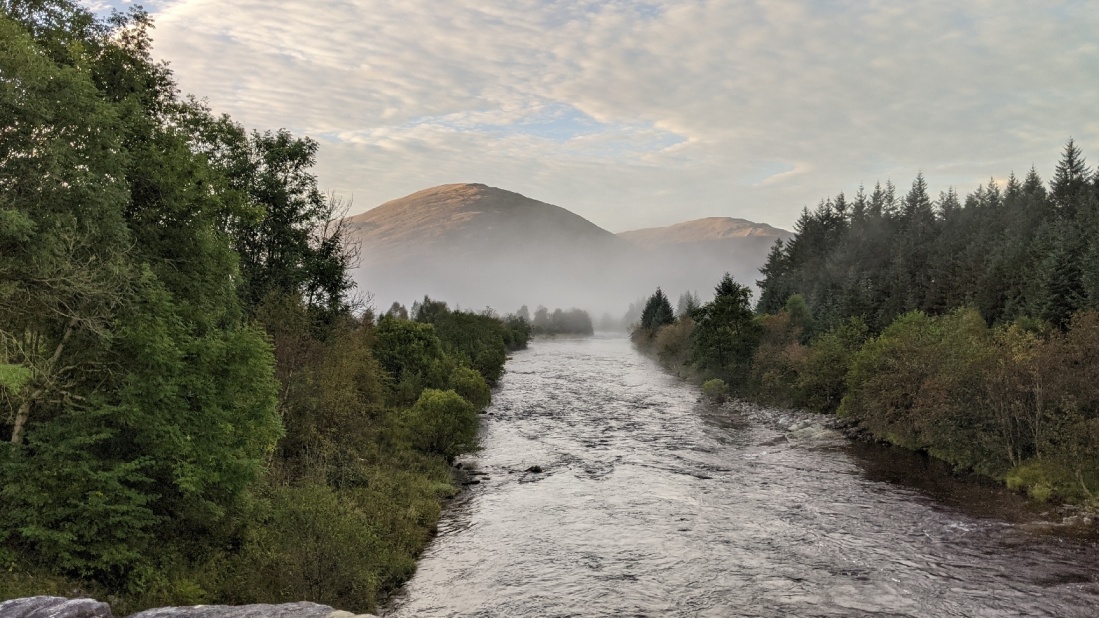
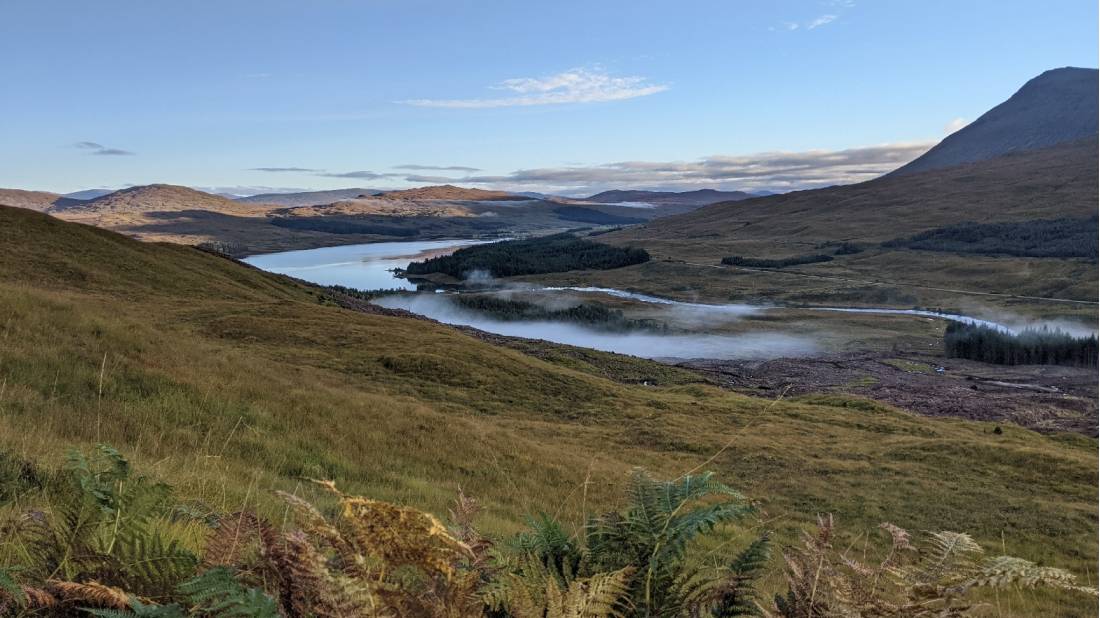
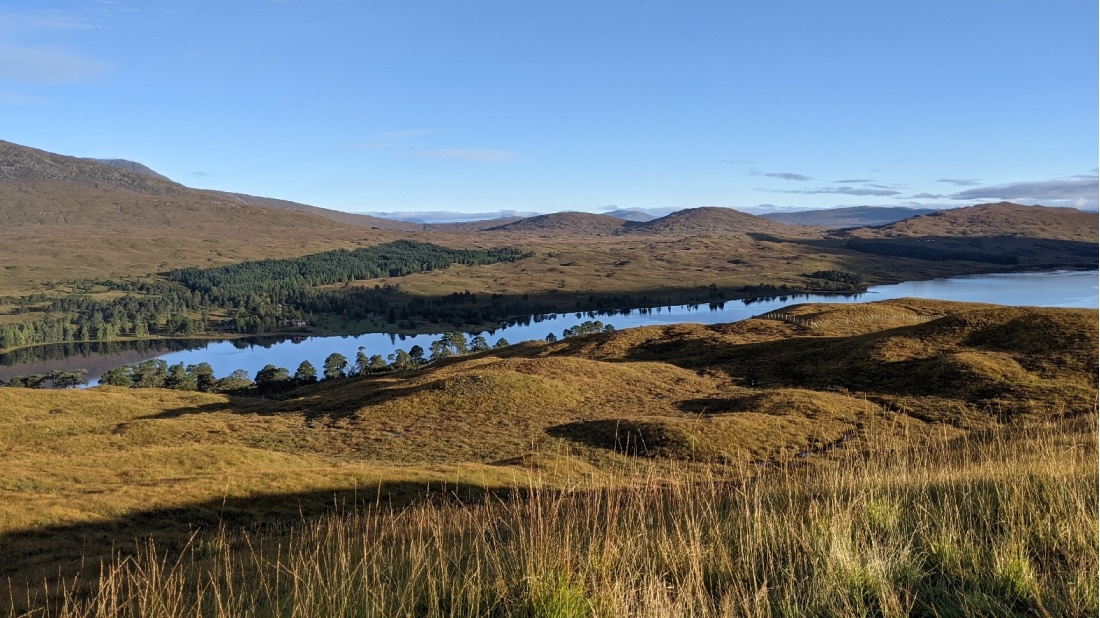
From there the path led down to a paved modern road for a kilometre or so and then turned off the paved road into what looked like an unused and abandoned motorway.
Telford's Parliamentary Roads went out of use as the main public road in 1933, but is still in good condition today as it is maintained for estate access and the West Highland Way.
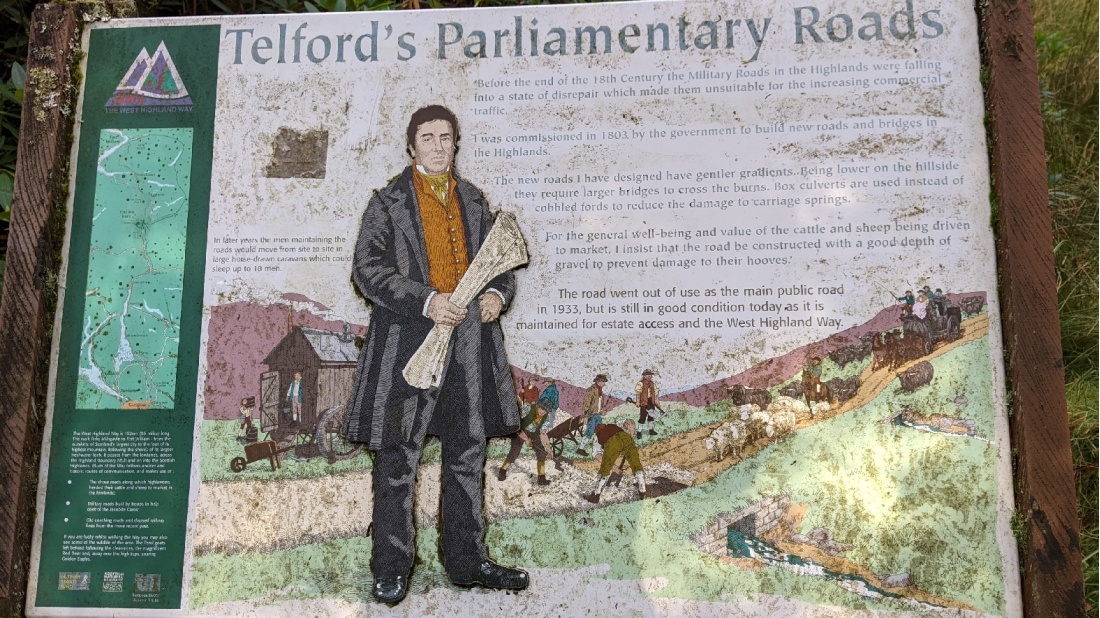
The path definitely proved to be an easy path to walk on with plenty of opportunities to take photos.
Fun fact: this Highland area is featured in many movies including Braveheart, Harry Potter and the Prisoner of Azkaban, and Monty Python and the Holy Grail (to name a few). I even passed the mountain that was in James Bond's Skyfall film.
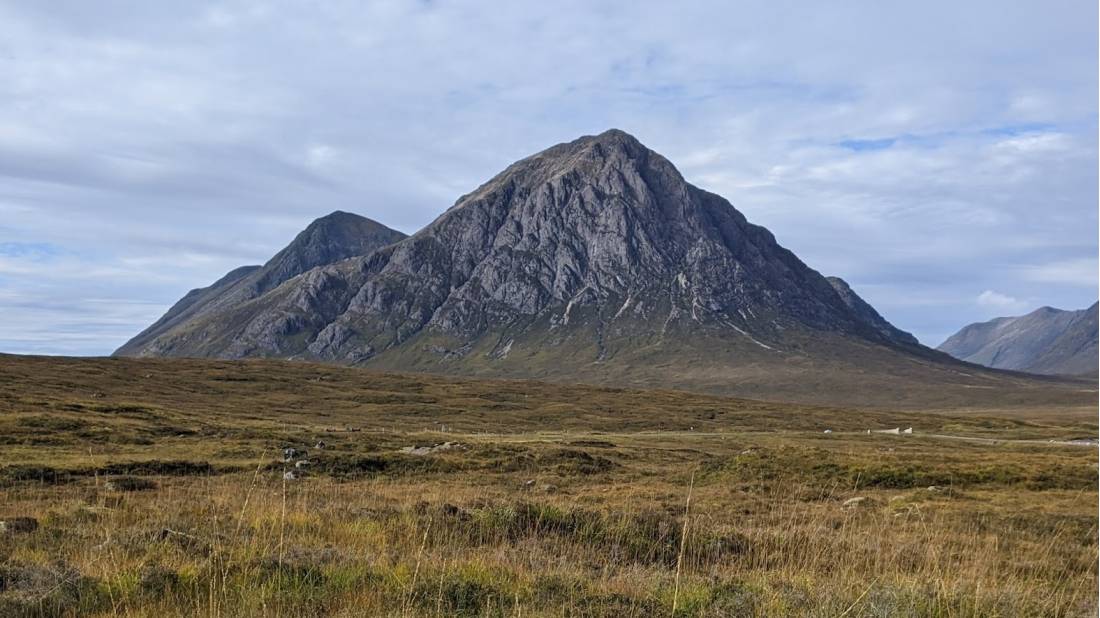
My destination for the night was the Kingshouse Hotel, the fanciest place yet. There are two bars, a giant dining area, and luxurious rooms that they wouldn't let me enter until 3 PM, at which time I had been sitting in the dining room for two hours.
Day 7: King's House to Kinlochleven
The stark mountains that could clearly be seen the day before were now covered in clouds and mist to make everything dark, grey, and silent. There wasn't a bird or an insect to be heard.
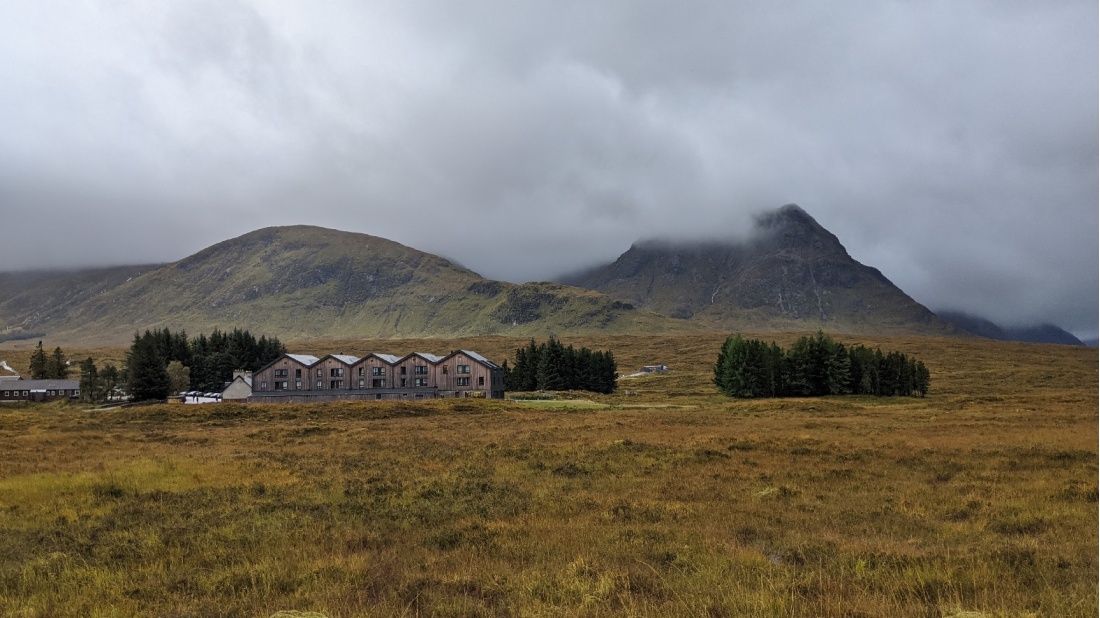
The path ran about 100 meters parallel to a major highway for 40 minutes or so and then turned away from the highway to begin a long series of switchbacks up the hills. It was another of these old British military roads.
The switchbacks were cursed by the British foot soldiers who had to carry heavy artillery up them. They nicknamed them "the devil's staircase." It was quite a slog and soon it was raining heavily.
Fortunately, by this time, I know that happiness in Scotland is walking with wet cold feet and I was getting happier by the minute.
Up and up finally started going downhill, which revealed a more forested path. The path passed a damn that had a series of monstrous pipes leading down from it to the final stop of the day – the old aluminium processing town of Kinlochleven.
The entire town had been built by the British Aluminium Company to house 700 workers who processed aluminium with electricity generated by the water flowing out of the giant pipes. When the factory closed in 2000 the town reinvented itself as a centre of outdoor recreation and today one of the old factory buildings has Europe's biggest ice climbing training wall. I found there was some charm to the town.
Day 8: Kinlochleven to Fort William
The path started off looking like the devil's staircase part two. Fortunately, it wasn't raining and after a few switchbacks, I was out of the forest.
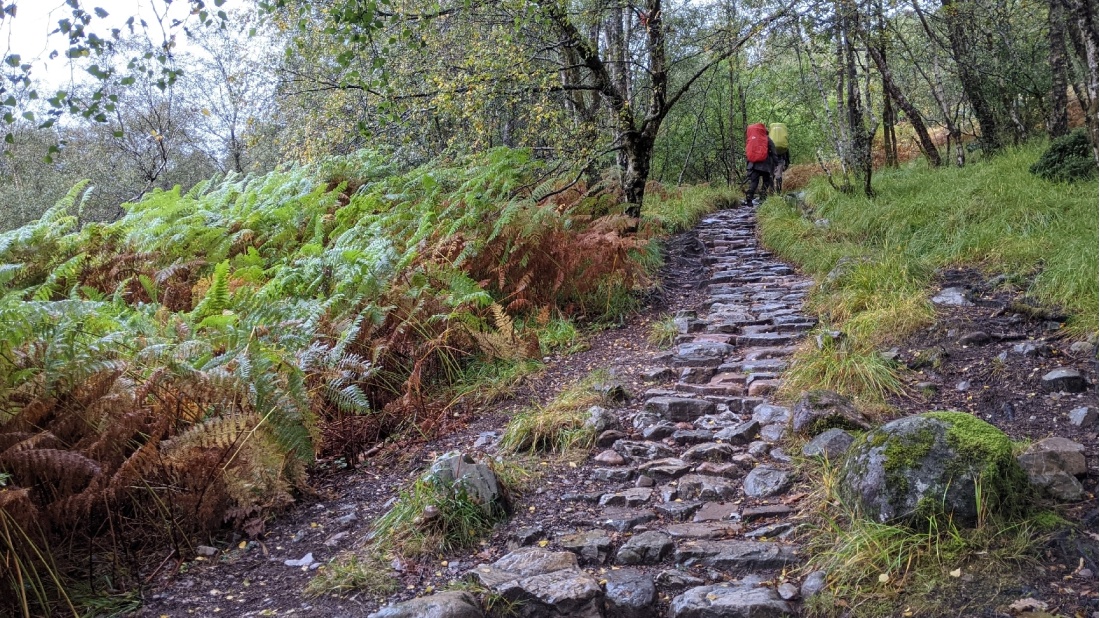
In the 1700s, the British forced many of the local people out of the area to prevent any possible rebellions. It is remembered (depending on who is telling the story) as ethnic cleansing. The ruins of some of their homes can still be seen. Someone told me that the United Kingdom, UK, should be called the 'BUK': the Barely United Kingdom. Here that means that the Scots have never forgiven the British for being repressive colonials.
A few miles west of here in the village of Glencoe is the site of a particularly brutal incident. In August of 1691, the English king told the local chiefs to take an oath of allegiance before January 1 of the following year. Unfortunately one of the chiefs, Alexander MacDonald, didn't take his oath until January 6.
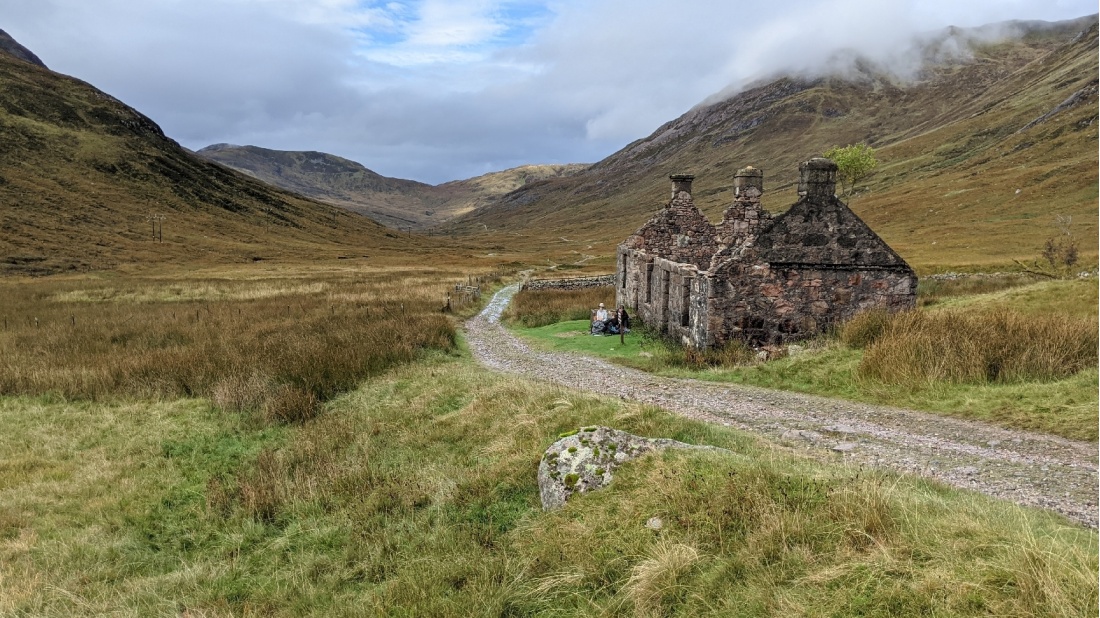
Always ones for punctuality, the English sent 100 soldiers to the MacDonalds to teach them some manners. The MacDonald clan hosted those soldiers for a week or so at which time the British massacred 38 of their hosts. Now, 330 years later the Scots haven't forgiven or forgotten what happened. I saw a sign along the path today to remind me.
After three pleasant hours of walking, I sat down to eat my lunch, and just as I finished, it started raining again. But by then I knew that I just had two more hours of walking before I would arrive at Fort William and the end of the walk.
Reaching Fort William, I posed with a made-for-pictures statue with a couple of hikers I met on the trail, which marked the conclusion of my walk.
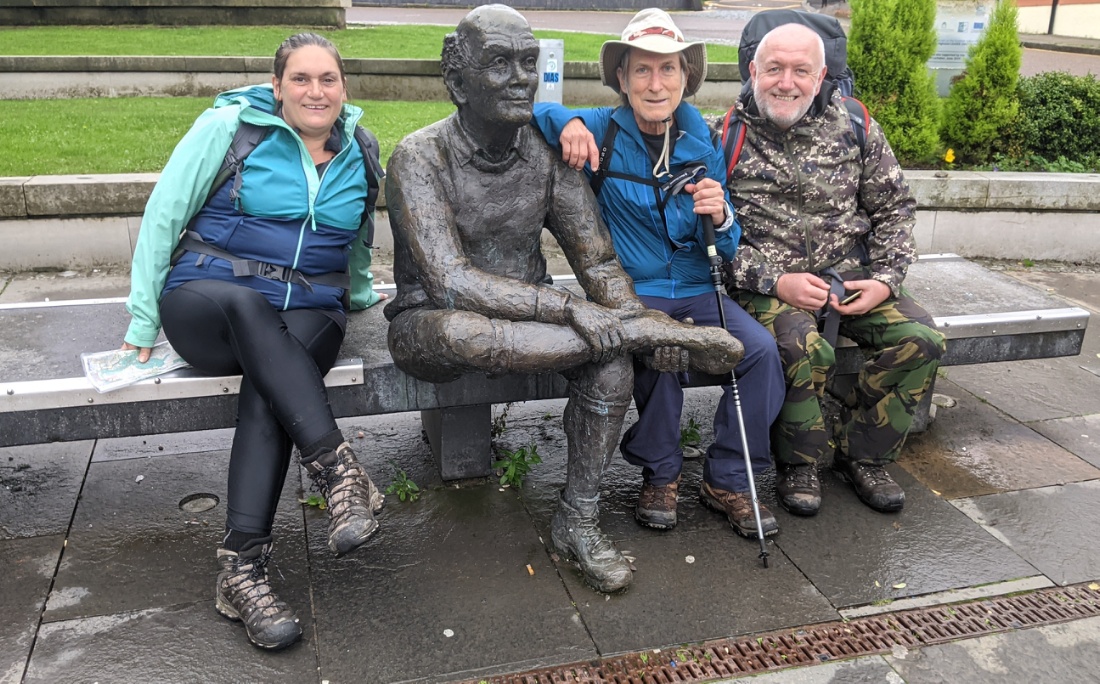
After a shower and changing into dry clothes, I knew that this was it and there was no going back: tonight I was going to drink Scotch whiskey.
I asked the manager of my guesthouse if she could recommend a local bar that specialized in Scotch whiskey. She suggested that I try one or two of the thirty-five different whiskeys in her whiskey closet, just beside the lounge. That sounded much better than going back out in the rain.
She was very enthusiastic. Whiskey in Scotland, I quickly learned, is like wine in France or beer in Milwaukee: it is a way of life and the pride of the nation. She told me that occasionally she will host German whiskey clubs who are touring Scotland and trying Scotches from some of the 130 distilleries. Before she served me she gave me precise instructions. I was first to enjoy the smell of the golden brown liquid, then I needed to swish it around my mouth, letting all of the subtle flavours sink in. Food, with whiskey, as well as ice, was forbidden.
A person should seriously, meditatively if you will, slowly savour and enjoy every sip and then let the palate and throat savour the aftertaste. I carefully followed instructions and after two 35 ml drams, it became clear that drinking Scottish whiskey was a wonderful way to enjoy an evening.
Words and images by Tom Riddle
Tom walked the West Highland Way self-guided in early October over 8 days, with accommodation and luggage transfers organised by Walkers’ Britain.
Postscript: Three weeks after I finished the walk, I found myself in one of the largest camping stores on the east coast of the United States. "Show me your best raincoat for hiking," I said to the sales person. He showed it to me and then tried to guide me to one that was less expensive. I was not impressed. "I've tried the less expensive ones and barely lived to tell the story. I'll take this one."